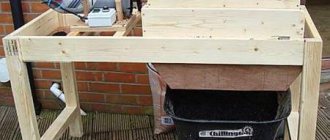Do you like to create furniture with your own hands, make a staircase in your house, decorate your house or bathhouse with curly trim? In this case, it will be difficult to do without a lamella or key router.
What is this device and what is it for? A key router cuts linear grooves into a piece of wood to install keys or lamellas. The method of connecting wooden parts using lamellas (oval-shaped wooden parts) gives reliability and strength to the entire structure.
Frames, tables, chairs, cabinets made by your own hands will delight not only the home craftsman with their individuality, but also all those who touch them.
Peculiarities
The design of a manual lamellar router is very similar to a grinder.
Only the cutting part of the tool moves parallel to the sole during milling.
The body itself slides in a horizontal plane.
In order to cut a groove for the lamella, a disk cutter is used.
Main details of the lamellar (keyway) router:
- Power unit (electric motor);
- Cone-shaped gearbox;
- Disc cutter;
- Frame ;
- Cord with plug;
- Cast platform;
- Rubberized handle;
- Bag for chips and dust.
Depending on the power of the power unit, milling cutters are divided into three types:
- Small 750 W - for hobbyists who use the tool to make single products.
- Medium 1100 W - used for the production of small batches of furniture.
- Powerful from 1200 W - professional equipment designed for full-time work. They are in demand in small furniture manufacturing industries.
In large factories with mass production of furniture units, stationary type milling machines are installed.
Let's describe the principle of operation of a lamellar milling cutter in a nutshell - rotational torque is transmitted from the engine through the gearbox to the cutter. The cutter itself is securely fixed to the shaft. The casing protects hands and foreign objects from getting into the cutting area. The cast platform allows the milling tool to be securely mounted on the surface in which the groove is being made. The rubberized handle makes it easy to use and press down if necessary.
The milling process produces fine wood chips and dust. It not only gets clogged into the mechanism itself, but can also enter the nasopharynx and lungs of a person. To prevent this from happening, a bag was developed to collect dust and small chips. It does not allow clogging of mechanisms, and, accordingly, does not cause engine overheating. In some cases, the router is connected to a vacuum cleaner using adapters.
The connecting piece itself, the lamella, cannot be ignored. The lamellas for the router are oval-shaped keys. They are strictly standardized, the number is indicated on the lamella itself. They can be purchased in stores, but some amateur craftsmen make them themselves. For this, plywood or chipboard 4 mm thick is used. More elite materials are oak and cedar. The use of this expensive material is the prerogative of experienced craftsmen, who first plan a plank of oak or cedar of the required thickness, and only then make dowels from it.
Storage of the lamella requires dryness and tightness. Air humidity affects the shape of the lamellas - with high humidity they swell and do not fit into the groove. And when they overdry, the lamellas warp and either do not fit into the groove, or dangle a lot, and ultimately do not perform their functions as connecting parts.
Design and principle of operation
The operation of the tool is based on the principle of converting electrical energy from a household AC network into mechanical energy. Entering the motor, the current causes the motor rotor to rotate, which drives the disk cutter through a gearbox. Due to its rotation, a keyway is produced in the workpiece.
Structurally, the milling cutter consists of the following elements:
- frame . It is the main load-bearing element of the structure on which other elements are attached. Inside it there is an electric motor, wiring and fuses, as well as a planetary gear that transmits rotation to the milling gearbox;
- handle . Serves to hold and guide the tool along the intended cutting line;
- milling gearbox . The main working part of the tool. It is in it that the disk cutter is fixed and the process of selecting a groove for the key takes place. Some models have a protractor with a scale that allows you to change the penetration angle, as well as a sampling depth regulator.
For greater convenience, the case can be equipped with a silicone insert, which ensures a safe and reliable grip of the tool in your hand.
Advantages
The main advantage of lamella routers is the cutting of grooves for the lamellas. And such connections have a number of advantages:
- The lamellar router can be used in horizontal and vertical positions.
- Connecting elements at any given angle. Such connections are very necessary when designing furniture products. This type of connection preserves the aesthetic appearance of the furniture.
- Performing technological operations at high speed. Very relevant for serial furniture production. When using a key router and a special cutting tool together, the productivity of the technological process can be significantly increased.
- Cost-effective when performing some work. Materials selected from the grooves can be used to insulate or decorate facades.
- Comparative safety.
How to make a manual wood router from an angle grinder with your own hands
Making a homemade router from a grinder with your own hands consists of several steps:
- First, the drill chuck is modified and must be secured to the spindle of the grinder. It is impossible to do this without preparatory turning, since the threads will not match. You first need to drill out the chuck on a lathe under M14, try it on the spindle and, if necessary, expand it a little more to suit the height and diameter of the centering belt.
The modified cartridge should not hang on the threads of the angle grinder spindle - The metal rod for the vertical rods of the milling cutter is ground to the required diameter and sanded manually with sandpaper. After this, blanks for the guides are cut with a jigsaw. Longitudinal holes are drilled in them, the verticality of the rods is checked using a square, and then guides and springs are put on them.
It is necessary to move the structural elements several times to ensure smooth sliding - Two identical plates are cut out of a sheet of plexiglass or metal using a saw and glued together with mounting adhesive. After this, four holes are drilled in the workpiece in the corners. The plates are additionally fastened with screws, then holes are made for the rods and the latter are inserted into the base.
The rods are secured on top with a metal plate in a vertical position. - Two identical elements are cut out of sheet metal and bent in a vice. These plates are then bolted on both sides to the body of the grinder in the holes provided for the handles. A grinder with a chuck and a cutter is installed in the center of the sole.
The grinder is placed in a horizontal position and the plates on its sides are welded to the sliding tubes - A hole for the cutter is made in the center of the sole with a ring drill. A strip of thick sheet metal is cut out, bent to the shape of the bracket, and welded to the sliding tubes horizontally at the front of the tool.
The diameter of the hole on the platform must be selected according to the largest possible width of the cutter - The rods are removed from the sliding tubes and holes are drilled in their lower side part. Threaded holes are also made at the end sides of the sole and retaining bolts are screwed in. Using a grinder, install a stop on the transverse bracket in the front part of the router yourself.
The metal plate at the top of the router is dismantled and a bracket is installed instead
At this stage, the home instrument is assembled. All that remains is to check all the fasteners for strength, tighten the bolts if necessary and check the DIY unit in operation.
Recommendations for selection
When planning to buy a lamellar tool, pay attention to the following main characteristics:
- Engine power. Depending on what you are going to do with a lamellar tool, it depends on what power the tool should be chosen. For a home workshop, a small lamellar machine is quite enough. A medium-power machine is needed when building a summer house, or, for example, a bathhouse or sauna. Trimming steps, connecting side panels on a staircase, terrace or balcony, creating decorative elements of the facade, cutting grooves and cutting quarters - this can be easily done with a medium-power lamellar machine.
- Possibility of adjusting the working angle. Nowadays, most modern devices have this feature, but we couldn't help but pay attention to it as it affects the functionality of the device.
- Cutter rotation speed. The cleanliness of the processing directly depends on the rotation speed of the cutter. Do not use a high-speed router for working with soft materials and wood boards. They are easy to process at low speeds.
- Clamp type for cutter (collet). The collet must be made of high quality metal. Don't buy an expensive router just because of a quality collet. It is enough to purchase a collet made of hardened steel and replace it if you are not satisfied with what is available.
- Speed adjustment. Allows you to select the mode that is necessary for processing a specific material. For hard materials (stone, brass, aluminum) fast rotation is required, but for softer ones it is not necessary.
- Blocking. Automatic protection. If there are children in the house, then blocking and automatic protection are simply necessary. In fact, this feature ensures the safety of your loved ones.
- Smooth start. Allows you to start the process of cutting grooves without sudden jerks.
- Working stroke of the milling cutter. If you need to make parts with deep longitudinal grooves, or grooves for leveling floor boards, you should pay attention to the working stroke of the lamellar cutter.
- Connecting a garbage bag. A vacuum cleaner or dust bag can be connected through the connecting elements. This ensures comfort in the workplace and safety for the health of the master.
Tabletop for router
To make a manual router from a drill with your own hands, you will first need to understand the table. It will be more convenient to process the ends, as well as milling grooves for joints using the tongue-and-groove method, using a milling table with protruding tools. They have a simple design, and the drawings will be easy to develop yourself. A small bench-type table will also work. The lid should flip over and a hole should be cut in it.
Its size should be approximately 0.5 cm larger than the maximum diameter of the cutter that will be used.
A bar will be installed perpendicular to the table, which will be parallel to the side at such a distance that the spindle axis of the attached electric drill will perfectly coincide with the center of the hole. The body of the electric tool should be attached to the bar with stops and clamps; in the normal state of the table, the chuck will be located under the cover, and the cutter inserted into it will protrude. During processing, the wood part will move along the surface of the table and rest against the template, as a result of which milling will occur.
In addition, the tool can be secured in other ways. The main thing is that the center of the hole perfectly coincides with the axis of the cutter, and that the chuck and switch are accessible. All machine elements must be attached rigidly, without any distortions.
Care
Every time after work, the router must be cleaned of wood dust.
This can be done with a vacuum cleaner, but the dust should not be sucked in, but blown out.
Or you can clean it with a brush - carefully sweep all surfaces of the instrument, removing dust and small particles.
In case of greater contamination (dirt that has become embedded in the connecting seams between parts), it is necessary to carry out radical cleaning with special products designed for wiping electrical equipment, or with gasoline. The entire cleaning procedure must be carried out with great care, preventing liquid from getting inside the instrument body or on the on-off system. If a similar situation arises, then the router needs to be dried very well and only then used.
In more expensive models, a vacuum cleaner is connected using adapters or a bag is installed to collect dust and small sawdust.
If vibration or unusual engine sound begins to bother you, then you should first of all pay attention to bearing wear. In these tools, the bearings themselves do not need to be maintained; if they wear out, they are replaced with new ones. It is better to replace bearings in a workshop, since special tools are needed to remove the old bearing and install a new one.
Materials used
The grinder is considered a multi-purpose device, on the basis of which various designs can be made. One of these devices is a router. Made from a grinder with your own hands, it copes only with simple cutting tasks. Such work will require the fulfillment of certain conditions, the main of which are ensuring good fixation of the tool in the plumb plane and its movement relative to the plane of the workpiece.
To make a milling machine from a grinder, the following materials are required:
- A grinder or drill with a running motor.
- Components with the support of which devices will be fixed in the structure. They must be strong and reliable.
- Base for mounting the router: thick plywood or thin-sheet alloy.
- Welder.
- Fastening components.
- A regular set of locksmith tools.
Characteristics
Pictured: Kress 800 FDF lamellar router.
Motor power
for both lamella and filler milling machines it is 590-800 W. Tool diameter, speed and depth
- “Lamelniks”
are equipped with a cutter with a diameter of 100 or 105 mm, which makes 9, 10 or 11 thousand revolutions per minute and plunges into the material to a depth of 20 or 22 mm. - Additive milling cutters
- their cutting equipment is replaceable, because dowels come in different diameters. You can install cutters with a “caliber” from 3 to 12 mm. The rotation speed is 18,500 rpm at idle, and the maximum milling depth is 40-43 mm.
Frequency adjustment
Lamella and filler milling cutters do not have it. These highly specialized machines simply do not need it.
Images used in this article: dewalt.ru, kress-tools.com, milwaukeetool.ru
Non-format
Makita BPJ180Z – stand-alone lamellar router
Battery powered lamellar. It would seem, why is it needed? Furniture is not assembled in an open field, and there is always an outlet in the workshop. Nevertheless, working without a cord turned out to be quite convenient. Moreover, this is a real Makita - by definition there are no questions about the quality of workmanship. The only thing missing is an adapter for mains operation (if the battery runs out at a critical moment).
Advantages:
- Full mobility, convenient to process long workpieces: no need to carry an extension cord.
- The battery holds a charge for a long time.
- Despite the low speed (6500), you can work with any tree.
Flaws:
- It is not possible to work directly from a 220 volt network.
- The battery adds significant weight: 3 kg.











